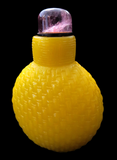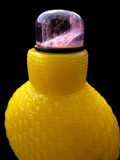Imperial Yellow Peking Glass Basket Weave Design Snuff Bottle. The Flattened Body In Opaque Imperial Yellow Glass Which Rests On A Raised Foot. The Neck With Scroll Design. The Top Of Pink/Red Tourmaline. Approximately 2 3/4" High x 1 7/8" Wide x 1" Deep. Small Dimple On Rim Of Base.
For A Similar Example:
Sotheby's Hong Kong - May 26, 2014 - SNUFF BOTTLES FROM THE MARY & GEORGE BLOCH COLLECTION: PART VIII:
Lot #1184
A Yellow Glass ‘Basket-Weave’ Snuff Bottle
Qing Dynasty, 18th / 19th Century
together with a watercolour illustration by Peter Suart 6.6 cm., 2 5/8 in.
PROVENANCE
Gerry Mack.
Janos Szekeres.
Sotheby’s New York, 5th June 1987, lot 41 and front cover.
LITERATURE
Moss, 1976, No. 3, p.55, pl. Z
Stevens, 1976, no. 187.
JICSBS, Autumn, 1987, p.30, fig. 1
Sotheby's, Art at Auction, 1987, p. 380.
JICSBS, Winter 1993, front cover.
JICSBS, Winter 2000, p. 13, fig. 40
Moss et al., 1996-2009, vol. 2002, no. 819.
CATALOGUE NOTE
The basketweave design, popular at court from the mid-Qing period, may have originated well before that period. References to oil-basket glass snuff bottles are found in the Yongzheng archival records as early as 1723, although it is likely that the characterisation often refers to the shape of the bottle rather than to this kind of basketweave design, especially where inlay work is mentioned. See Sale 2, lot 56 and Sale 6, lot 184 for examples in other materials. This design was still being made imperially in the Daoguang period. It appears on an extraordinary enamelled porcelain bottle made during the latter part of the Qianlong era, complete with reign mark (Kleiner 1999, no. 138 and Chinese Snuff Bottles No. 5, p. 74, fig. 88).
Owing to its impressive provenance, this is one of the most frequently published and exhibited bottles in the collection. It is a strong candidate for a Qianlong date. The relatively low intensity of the yellow is reminiscent of Sale 5, lot 133: it is probably among the earlier shades of yellow produced at the court, but also likely to have remained in continued use thereafter. Genuine early basketweave bottles in yellow glass are extremely rare, although see another in Kleiner 1990, no. 7.They also exist in other colours (see Sale 2, lot 71, Moss, Graham, and Tsang, 1993, no. 352, and Stevens 1976, no. 159, for instance), but even these are infrequently found. Given the proliferation of basket-weave bottles in other materials, it is suprising to find so few in yellow glass.
The matching of design to form here is spectacular, with each vertical strand of wickerwork tapering elegantly towards foot and neck in order to adjust them to the curving surface. Because the compressed form is so radically different from the bulbous form that it emulates (that of a container for liquid, possibly oil, encased in protective wickerwork wrapping), there is of necessity some departure from realism at the narrow sides.
The bottle was certainly blown, probably into a mould, but there is no evidence that the basket-work design was included in the mould; it must have been added at the jade workshops, where the requisite lapidary skills were available.
Estimate 200,000 — 250,000 HKD
25,792 - 32,240USD
LOT SOLD. 875,000 HKD (112,840 USD)





























